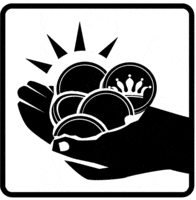Mixed Coins Worksheets
In the United States we have two forms of cash that are physically traded for goods or services. They come in the form of coins or bills. All the coins currently in circulation are worth less than one dollar. So, they account for the decimal side of the value of money, unless you have a whole bunch of coins. Then it can get heavy and worth a great deal of money. I save all the coins that I get from the store in the door of my car. I haven’t cleaned that door out for years until this summer. I put all of the change into a 5-gallon pail, from the door. Yeah, it was that big! It also weighed over forty pounds. These worksheets help students learn how to count coins when there is a mixed of different coin values.
Aligned Standard: 2.MD.C.8
- Cashier Training Step-by-Step Lesson- What's the quickest way to make forty-eight cents?
- Guided Lesson - Make sixty cents, total a value for us, and more training for cash register work.
- Guided Lesson Explanation - This is appropriate for this level, because it all based off of whole dollar values.
- Practice Worksheet - Determine what coins and bills you will need to make dollar values.
- Matching Worksheet - This is one that will take you a while to complete.
- Answer Keys - These are for all the unlocked materials above.
Homework Sheets
It is important to focus sometime on the placement of the cent and dollar symbol.
- Homework 1 - How many coins do you need to reach the amount shown? 36¢
- Homework 2 - What is the dollar and cents value of the following?
- Homework 3 - What is the value of the following?
Practice Worksheets
A really nice variety of different ways to see this skill can be found here.
- Practice 1 - I like to start by using the largest coin until I can’t use it anymore, then I move on to smaller coins.
- Practice 2 - 58¢ = quarters ____ dimes ____ nickels ___ pennies _____
- Practice 3 - I like to have students write the value of each coin below it.
Math Skill Quizzes
In these we describe the change rather than showing you the coins.
- Quiz 1 - What is the total value of each?
- Quiz 2 - How much of each coin do you need to reach the amounts shown?
- Quiz 3 - The dollars column is a cinch.
Tips for Counting Coins

Do you have a jar of loose change, and you are dreading to count the amount? Well, words of advice, the amount is only going to increase, and you might as well want to start now. There are full businesses out there that are focused on performing this simple task for you in exchange for a share of your hard-earned coins. Why not just learn how to do this quickly and efficiently by yourself?
The first thing that you need to do is understand what coins there are. There are only four coins that are in circulation today. In ascending order of value: penny, nickel, dime, and quarter. You should learn more about each of these coins to better understand their use, how to identify them, and their value.
Penny - The penny has been issued since 1793. The penny is worth one cent and is the only cooper colored coin. Abraham Lincoln is on the front side of the penny.
Nickel - A nickel is worth five cents. The front of a nickel has a picture of Thomas Jefferson and the back has a picture of his home. This coin is silver in color and is not as big as a quarter, but bigger than dime in size.
Dime - This is the smallest of the silver-colored coins. It is worth ten cents. It is equivalent in value to ten pennies or two nickels. Franklin Roosevelt is pictured on the front of the dime.
Quarter - In current circulation, this is the highest valued coin. It is worth twenty-five cents which is the equivalent of twenty-five pennies or five nickels or two dimes and one nickel. This wasn’t always the highest value coin. The half dollar coin was previously minted but is not currently in circulation. The quarter is the largest silver colored coin with a picture of George Washington on the front of it.
What Is The Best Way to Approach Counting Mixed Coins? - The first step you need to take is to gather all your coins together. Empty your jars, your money houses, your pockets, or any other places where you keep your coins. Now, start separating the coins based on types. Make individual stacks of dimes, quarters, dollars, and so on. Take one pile at a time. Let's say that you are working on dollars, then make sure that you pay attention to the dollar pile only. Forget that there are other stacks of coins lying there as well. After you have chosen which stack to count first, start making piles of 10. It is easy to count and multiply. If the stacks have coins less than 10, just make one stack. Write down the number of stacks you have. Multiply the number of stacks with 10. Then multiply the number of coins with the coin’s value. Now add the number of coins that didn’t make stacks of 10. Keep repeating this method for each coin stack. Add the final number of each stack to get the final amount.